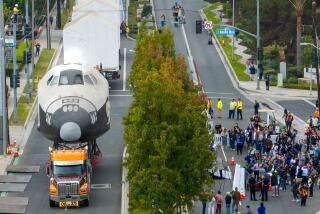Shuttle’s route will be a tight squeeze
The space shuttle’s drive from Los Angeles International Airport to Exposition Park over the next few days is shaping up to be an L.A. commute like no other.
While Endeavour will travel at a top speed of only 2 mph, it will be forced to do some maneuvers as nerve-racking as any high-speed pursuit. At five stories tall and 170,000 pounds, the shuttle is so big that any shift in winds or unexpected weather could bring the move to a halt. At several points along the 12-mile route, the spacecraft will be inches away from buildings, even protruding onto driveways and over sidewalks.
And the girth of the shuttle and its transporting equipment is so enormous that the streets along the route had to be dotted with heavy steel.
Engineers concluded that the city streets could not support the weight -- the equivalent of 30 elephants -- so they gathered maps and blueprints to identify all the gas lines, sewers, water pipes, drainage systems and other utilities that needed protecting.
This week, workers installed nearly 2,700 large metal plates in strategic areas along the way. Each plate weighs as much as a small car. And officials had to truck them in from as far away as Arizona and Nevada to get enough for the project.
“The sheer number of the plates was surprising,” said construction consultant Michael Volchok. “We’ve tapped out everything in Southern California.”
Although much attention has been focused on the 393 trees cut down to make way for the shuttle, carpeting the route with the steel plates was just as major an undertaking.
Each plate needed to be carefully placed on the ground, welded into place and surrounded with asphalt to make the shuttle’s passage smooth.
The task of plate placement fell to engineer Richard Plump and his team. Plump is a veteran of moving massive things. He was part of the crew that helped move the huge Los Angeles County Museum of Art rock across Southern California earlier this year, and has helped transport giant equipment to the port of Long Beach and the San Onofre nuclear power plant.
Making the road safe for the shuttle took months of planning, but Plump this week declared the streets ready for the big ride.
“This was a piece of cake,” he said as he watched welders lay the final plates along Crenshaw Boulevard near Slauson Avenue.
With the move set to begin Thursday just before midnight, the streetscapes look radically different from how they did months ago. More than 200 streetlights have been removed, along with nearly 60 traffic signals.
“Believe me, those engineers and aeronautics people have measured every inch of every square,” LAPD Lt. Andy Neiman said at a community meeting last week.
The move will begin when Endeavour crawls across LAX’s north runways to Northside Parkway, where it will cross Lincoln Boulevard en route to Westchester Parkway. The shuttle will stop at a parking lot at La Tijera Parkway for a roughly nine-hour layover as crews widen the transporters to move over Manchester Boulevard’s medians.
There will be an army of workers both ahead of and behind the shuttle. The advance team will be shutting off power lines that cranes will lift so the shuttle can clear them. After the spacecraft proceeds through, another team will restore power and move the lines back down.
The first big challenge will be when the shuttle crosses the 405 Freeway on the Manchester bridge. The shuttle will first be removed from its transporter and taken across the bridge using dollies. The California Department of Transportation required this change because the shuttle’s transformer didn’t meet state requirements. The craft will then be placed back on the transporter on the other side of the freeway.
Perhaps the trickiest maneuver will occur a few miles away at Crenshaw Drive, where the shuttle will come within inches of buildings on either side of the street. To give it as much room as possible, the advance crews will lay down a compacted base of material that will level the street so it is the same height as the sidewalk.
“It’s a very narrow stretch for us,” said Marty Fabrick, hired by the California Science Center to orchestrate the move. “Our wings will be over some driveways.”
The second team will then immediately scoop up the material from the road.
Because the shuttle needs every millimeter of space for clearance, L.A. police said they planned to close most sidewalks along the route. However, officials said this week that some may be opened along the way for public viewing.
As the shuttle crawls along Martin Luther King Jr. Boulevard, movers will keep a close eye on the pine trees on either side of the street. While many trees were removed to make way for the shuttle, the pines planted in honor of the slain civil rights leader were deemed too significant to cut down.
Because the trees dot both sides of the roadway, the shuttle will pivot along to avoid any mishaps. Endeavour will do the same along other parts of the route to dodge other obstacles, but officials identified this stretch as one of particular concern.
“Don’t think of the shuttle going nose-first down every street,” Neiman said. “That shuttle has the ability to zigzag and maneuver, and that’s what you’re going to see along that route. There may be places where the shuttle is going sideways at an angle.”
Although the shuttle move is in a league of its own, its journey is not without precedent. In 1946, workers gingerly moved pieces of Howard Hughes’ massive aircraft the Spruce Goose from Culver City to Terminal Island. As in the case of the shuttle, street lights and signs were moved as police guided the 191-foot-long, 34-ton wings down local streets. The 28-mile trek was described as “the biggest airplane moving job in history” and went off without a hitch.
Officials are expecting similar results this weekend.
“You break it up into a chunk, or into parts, and it’s still just another job,” Volchok said.
--
angel.jennings@latimes.com
More to Read
Sign up for Essential California
The most important California stories and recommendations in your inbox every morning.
You may occasionally receive promotional content from the Los Angeles Times.











